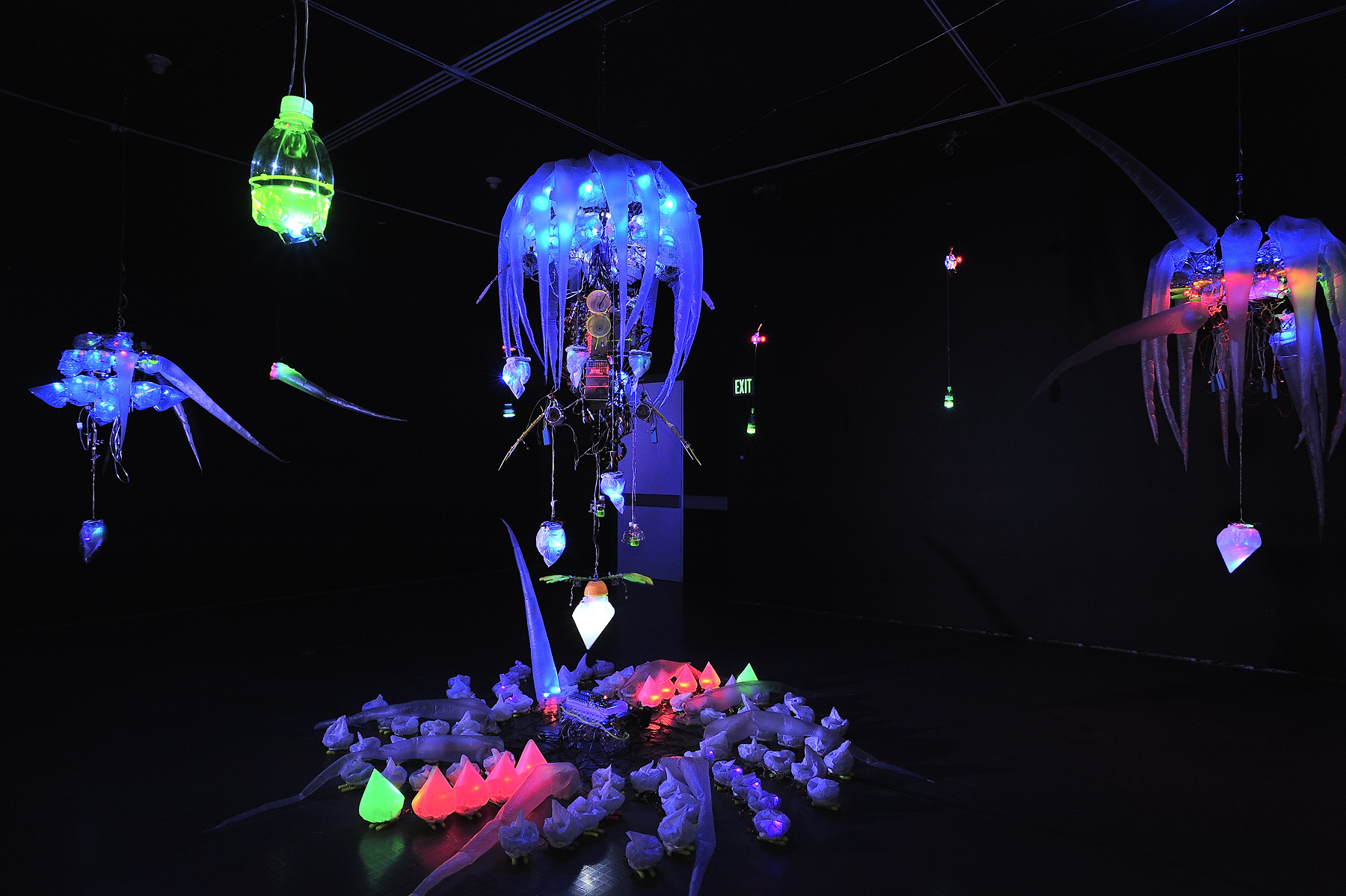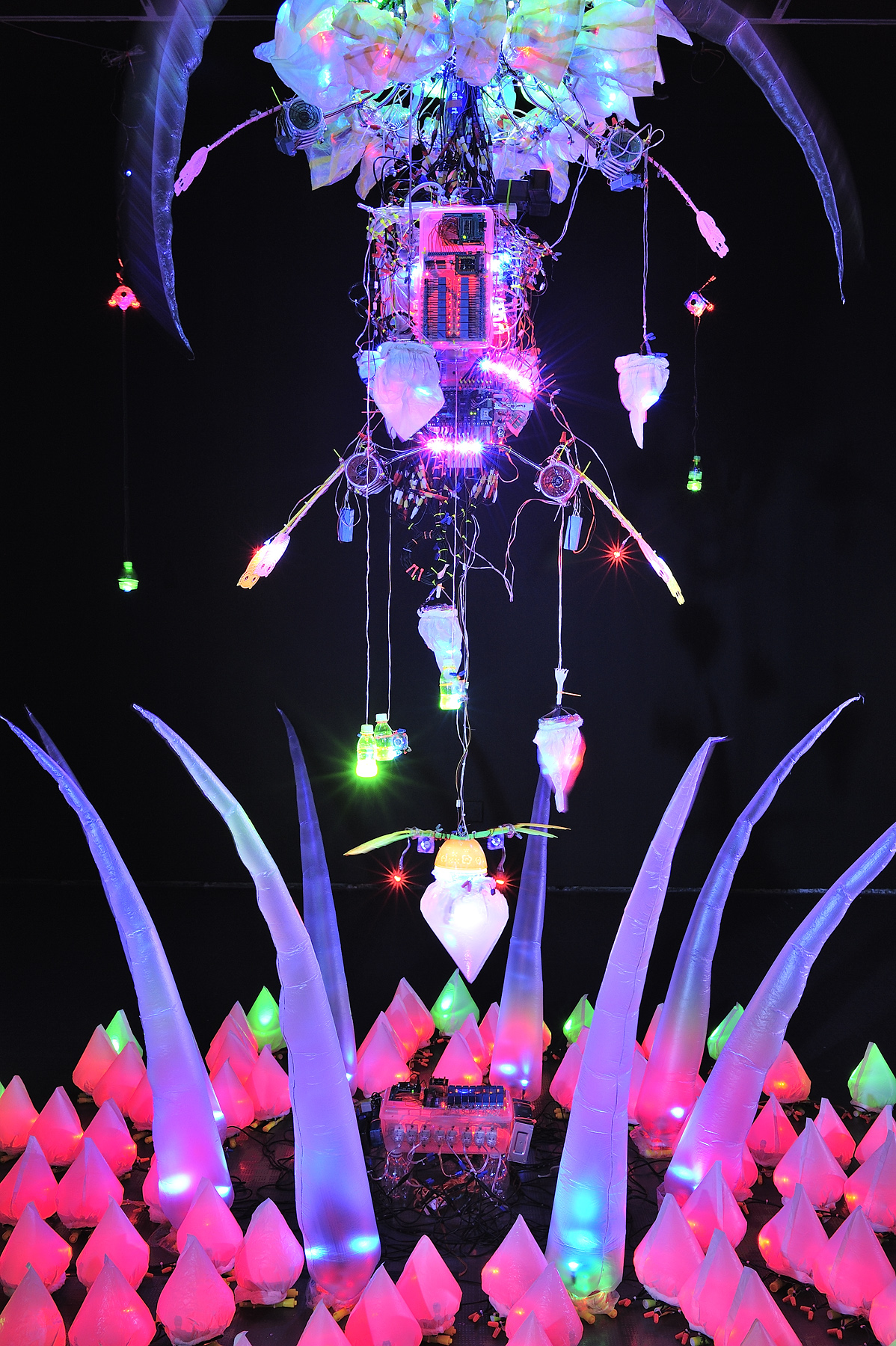Shows
Shih Chieh Huang’s “Synthetic Seduction”


Peering into a dark room on the second level of San Franciscoʼs Yerba Buena Center for the Arts, visitors were met with a seemingly random array of junk-like objects, hanging from the ceiling and placed on the floor. Stepping closer, the objets d’art came to life, emitting a mélange of neon colors and mechanic sounds, enchanting the space with their audiovisual eccentricity. The eclectic ensemble was part of “Synthetic Seduction,” the solo exhibition of Taiwanese artist Shih Chieh Huang. Featuring bright sculptural works, the show explored the mechanism of bioluminescence—the production of light by living organisms—as seen in deep-sea creatures such as jellyfish and squid.
The main installation was EX-DD-06 (2006), which comprises assemblages of plastic bags, bottles and fly swatters, as well as lights, fans, motion sensors and computer motherboards. Each cluster hung from the ceiling like a cyborg jellyfish; three large ones dominated the exhibition space, but smaller ones were scattered throughout the room. One of the larger elements, which has big, translucent tentacles spilling forth, hung above a floor contraption that resembles a giant sea anemone. The floor piece, which also features sprouting tentacles, houses a mechanical apparatus that operated the installation, and is surrounded by a series of plastic-bag-wrapped light fixtures. The many lights constantly changed colors—pink, green, purple, yellow, blue—and the bags inflate and deflate as if alive.
One of the other two large clusters, which hung on opposite sides of the central element, houses a small video screen implanted between its tentacles and displaying a grotesque pair of human eyes. Garishly made-up with neon yellow and pink eyeliner, the eyes are inverted and crossed, giving the impression of derangement. When approached, they awake, blinking and shifting as the rest of the installation lights up and produces a whirring sound. Such watchful eyes are disturbing at first, yet one cannot help but be intrigued by the eerie, anthropomorphic quality that they lend to the mechanical installation.

Less inspiring was a separate video piece played in fast-forward, which documented the making of EX-DD-06 by Huang and his assistants in his studio. Here, it is revealed that the aforementioned pair of eyes is Huang’s own, and the artist explains the technical manipulation he used to create the uncanny effect. Though this behind-the-scenes glimpse is illuminating, ultimately the exposition of the works’ mechanisms and “tricks” undermines the installation’s sense of mystery.
Numerous sketches of EX-DD-06 also accompanied the exhibition, unframed and pasted directly on the wall. Some of these cryptic digital renderings and blueprints, as well as drawings scanned from Huangʼs sketchbooks, are technical and near-scientific, while others are humorous, lurid and fantastical. The hand-drawn sketches range from whimsical jellyfish and frogfish to futuristic hybrid sea-monsters and graphic renderings of human genitalia. These drawings provide a fascinating look into the conceptualization of Huangʼs phantasmagoria.

Bioluminescence is utilized by certain marine organisms to hunt for prey and defend against predators, as well as to attract reproductive mates. In “Synthetic Seduction,” Huang, staying true to his cited inspiration, employed similar means to attract the visitor’s attention. His playful and hypnotic mechanical installations, which resemble creatures floating in the deep sea, effectively “seduced” viewers to engage with, and reflect on, his interpretation of a unique evolutionary phenomenon.
Synthetic Seduction was on view at Yerba Buena Center for the Arts from March 1–July 7, 2013.







